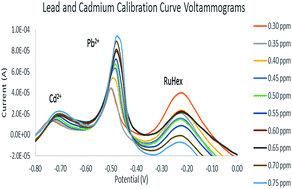Gold nanoparticle/hexaammineruthenium/Nafion® modified glassy carbon electrodes for trace heavy metal detection in commercial hair dyes
Abstract
Gold nanoparticle (AuNP)/hexaammineruthenium(III) ([Ru(NH3)6]3+)/Nafion® modified glassy carbon electrodes (GCEs) were fabricated and used as working electrodes in the determination of lead and cadmium in commercial hair dyes. The reversibility and stability of the modified electrodes were examined using cyclic voltammetry in which the voltammograms showed reversible peaks. Lead (Pb2+), and cadmium (Cd2+) were detected through anodic stripping voltammetry. The AuNP–[Ru(NH3)6]3+ amount chosen to detect lead and cadmium in hair dyes was 3 mg and 1 mg, respectively, since it was able to simultaneously detect the said metal ions. Furthermore, the peak current and metal concentration displayed a linear relationship with strong correlation values from 0.30 part per million (ppm) to 0.75 ppm for Pb2+ and Cd2+. The limits of detection are 0.0450 ppm and 0.20 ppm for lead and cadmium, respectively. Atomic absorption spectrometry was used to verify the concentrations in each solution.



 Please wait while we load your content...
Please wait while we load your content...